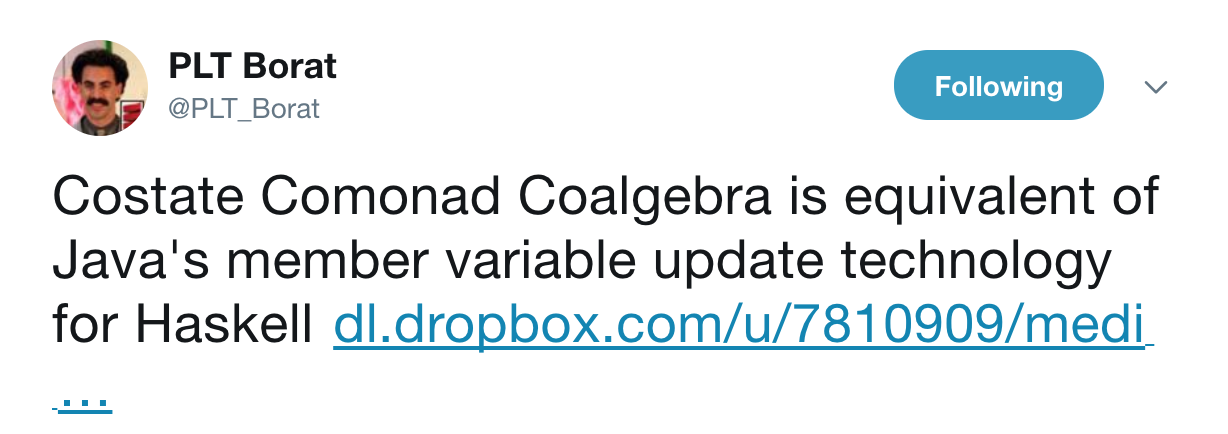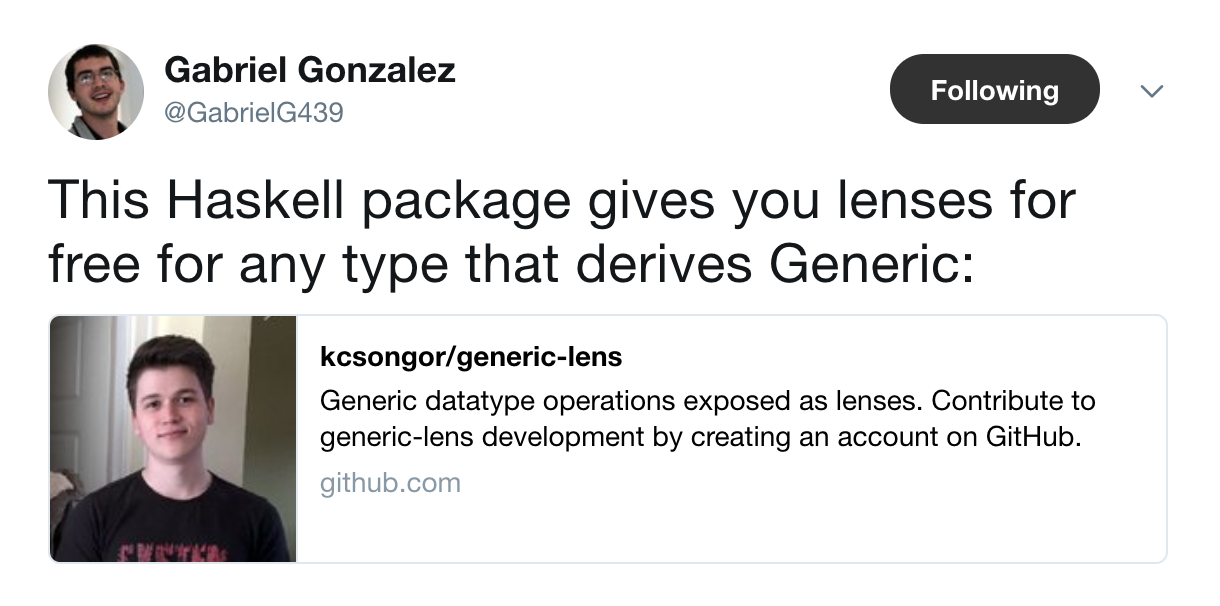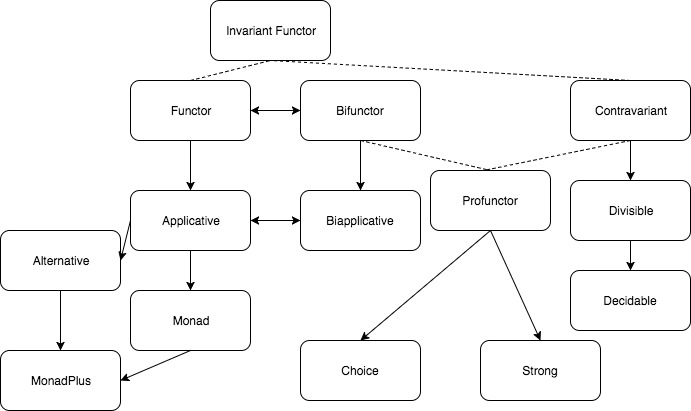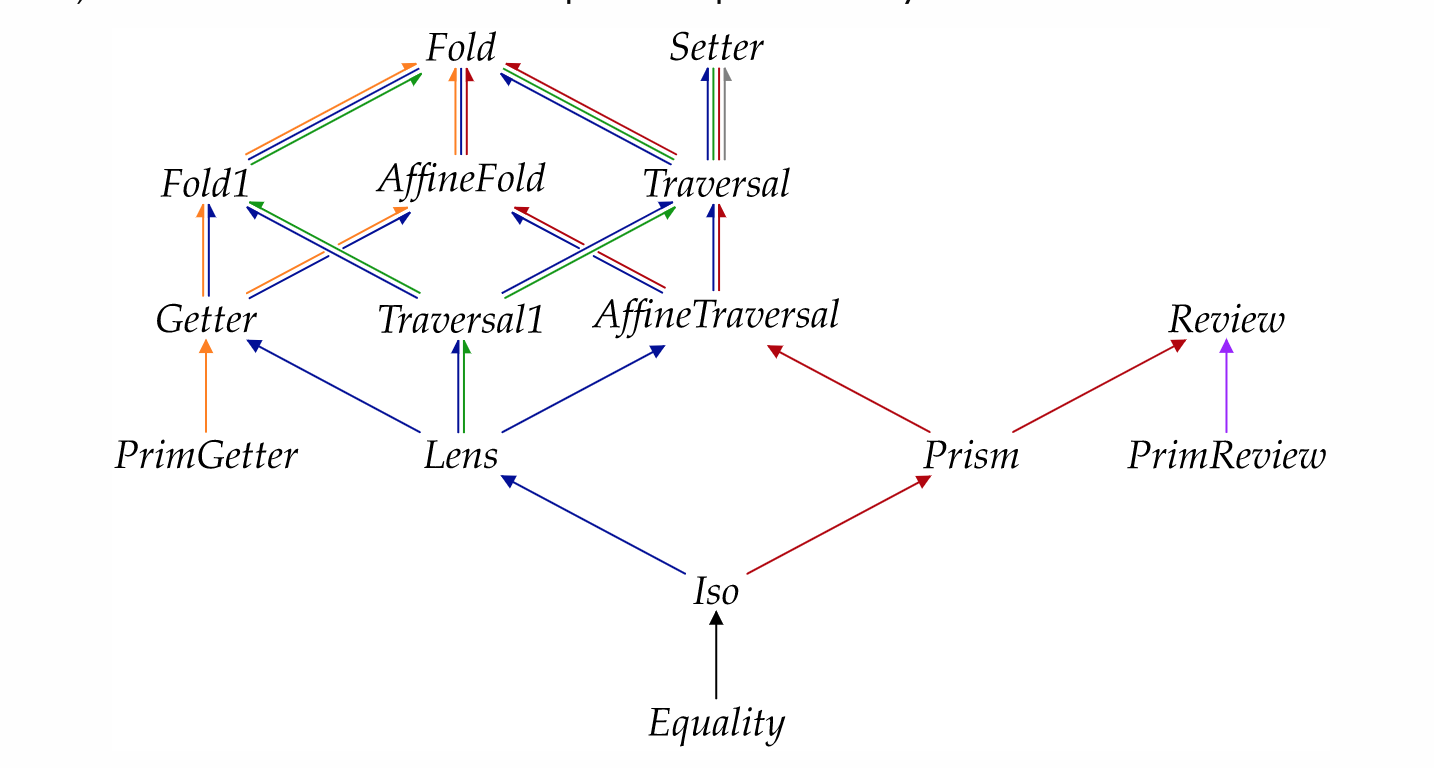Lenses and Optics
Purely functional references for traversals

Motivation
Promoting immutable programming.
Immutability simplifies a lot of concurrency woes.
However it makes working with certain data structures very difficult. Eg: Maps
Maps are ubiquitous.
- JSON
- OOP classes
- Haskell Records
- Caches
- Databases
- ..
Nearly everything useful you interact with has a map like API
Lets look at some problems working with Haskell records.
A very simple use case
data Person = P { name :: String
, addr :: Address
, salary :: Int
}
data Address = A { road :: String
, city :: String
, postcode :: String}Let us try to change the name of the person.
setName :: String -> Person -> Person
setName n P { name = n'
, addr = a
, salary = s}
= P { name = n
, addr = a
, salary = s}That was not bad!
Lets try to change his address
setPostcode :: String -> Person -> Person
setPostcode pc P { name = n
, addr = A { road = r
, city = c
, postcode = p}
, salary = s}
= P { name = n
, addr = A { road = r
, city = c
, postcode = pc}
, salary = s}This is starting to look ugly
A real world example from a medical site:
{
"problems": [{
"Diabetes":[{
"medications":[{
"medicationsClasses":[{
"className":[{
"associatedDrug":[{
"name":"asprin",
"dose":"",
"strength":"500 mg"
}],
"associatedDrug#2":[{
"name":"somethingElse",
"dose":"",
"strength":"500 mg"
}]
}],
"className2":[{
"associatedDrug":[{
"name":"asprin",
"dose":"",
"strength":"500 mg"
}],
"associatedDrug#2":[{
"name":"somethingElse",
"dose":"",
"strength":"500 mg"
}]
}]
}]
}],
"labs":[{
"missing_field": "missing_value"
}]
}],
"Asthma":[{}]
}]}To change the strength of a medicine, which is buried 6 level deep, we have to reconstruct the entire record.
This will cost you the entire reconstruction time and space!!
Don't even bother trying!!
Introducing Lens
Hassle free data traversals à la Edward Kmett
The Hack
(.) in Java acts as an accessor
employee.setAddress.setPostcode("NG7 2AW")(.) in Haskell acts as function composition
(.) :: (b -> c) -> (a -> b) -> a -> cLens composes functions in a way, that presents a seemingly MUTABLE API, for immutable programming, via the magic of function composition
Let's try to build a basic Lens type
A Lens primary comprises of 3 functions
- view
- set
- modify
view
Given a structure we want to view or "focus" on a particular part of the structure
set
Given a particular value to be set and a structure we want to create a new structure with that value set
modify
Given a function to modify a part of the structure we want to apply that function to the part of the structure and return the structure
Lets write the types!
data LensR s a
= L { view :: s -> a
, set :: a -> s -> s
, modify :: (a -> a) -> s -> s
}What about IO interactions?
data LensR s a
= L { view :: s -> a
, set :: a -> s -> s
, modify :: (a -> a) -> s -> s
, modifyIO :: (a -> IO a) -> (s -> IO s)
}What about interactions which can fail?
data LensR s a
= L { view :: s -> a
, set :: a -> s -> s
, modify :: (a -> a) -> s -> s
, modifyIO :: (a -> IO a) -> (s -> IO s)
, modifyM :: (a -> Maybe a) -> (s -> Maybe s)
}What about stateful interactions?
data LensR s a
= L { view :: s -> a
, set :: a -> s -> s
, modify :: (a -> a) -> s -> s
, modifyIO :: (a -> IO a) -> (s -> IO s)
, modifyM :: (a -> Maybe a) -> (s -> Maybe s)
, modifyS :: (a -> State s a) -> (s -> State s s)
}Can you notice a pattern?
Every interaction is falling into this pattern
modifyFoo :: (a -> Foo a) -> (s -> Foo s)And if you really squint your eyes:
set :: a -> s -> sview is the only function whose types do not visibly seem similar
Let us try to capture the entire pattern using one function excluding view
type Lens f s a = (a -> f a) -> (s -> f s)A short digression
Jargon time
- Higher Rank Polymorphism
- Functors
Constraints liberate. Liberties constrain.
Eg:
foo :: Num a => a -> a foo :: Bool a => a -> a
foo 5 = 6 foo True = False
foo 6 = 8 foo False = True
foo ... foo ...Now lets liberate the type level
foo :: forall a . a -> a
foo x = xFunctors
A functor is a Higher Kinded Type
class Functor f where
fmap :: (a -> b) -> f a -> f bHigher kinded types take one or more types and return a type.
IO, Maybe, State are all monads.
But all monads are functors.
Functors are weaker than monads but they have laws
fmap id = id
fmap (f . g) = fmap f . fmap gBack to lens
Lets combine higher rank polymorphism and functors
Van Laarhoven Lens
One function to rule them all
type Lens s a = forall f . Functor f => (a -> f a) -> (s -> f s)Claim: view, set and modify are all captured by this function.
Lets look at view
view :: s -> atype Lens s a = forall f . Functor f => (a -> f a) -> (s -> f s)Seriously? How on earth?
Say hello to the Const type
newtype Const v a = Const v
getConst :: Const v a -> v
getConst (Const x) = x
instance Functor (Const v) where
fmap f (Const x) = Const xview :: forall s a . Lens s a -> s -> a
view ln s = ?λ> :t Const
Const :: v -> Const v aRemember:
type Lens s a = forall f . Functor f => (a -> f a) -> (s -> f s)Now,
(a -> f a) ≡ Const ≡ (a -> Const a a)
s ≡ sSo
ln Const s ≡ Const a sHence
view :: forall s a . Lens s a -> s -> a
view ln s = getConst $ ln Const sSimilarly,
Using the identity functor we can get
set :: forall s a . Lens s a -> a -> s -> s
set ln x s = runIdentity $ ln (\_ -> Identity x) smodify :: forall s a . Lens s a -> (a -> a) -> s -> s
modify ln f s = runIdentity $ ln (Identity . f) sLENSES COMPOSE!!
Because it is just a function
Remember the old medical site example
Lets compose our way into its depth:
Lens Problem Disease .
Lens Disease Medication .
Lens Medication MedicationClass .
Lens MedicationClass Classname .
Lens Classname Drug .
Lens Drug String
= Lens Problem StringThat was just plain old function composition!
And making a Lens can be incredibly automated
import Control.Lens.TH
$(makeLenses ''Problem)
$(makeLenses ''Disease)
$(makeLenses ''Medication)
...And if you don't like metaprogramming

Generalizing the Lens type
type Lens s t a b = forall f . Functor f => (a -> f b) -> s -> f tIs that all?
How big is the functor family?

The functor hierarchy existing in Haskell excluding lots of interesting categories

Constraining this in various ways
type Lens s t a b = forall f . (??) => (a -> f b) -> s -> f t
But thats too much jargon for my taste!
Edward Kmett on Haskell reddit


Lets talk performance
Lens inlines aggresively

Inlining example from SPJ's talk
view :: Lens s a -> (s -> a)
view ln = getConst . ln Const
-- Template Haskell generated
name :: Lens Problem String
name elt_fn (P n s)
= fmap (\n' -> P n' s) (elt_fn n)view name (P {_name = "Fred", _salary = 100})
-- inline view
= getConst (name Const (P {_name = "Fred"}))
-- inline name
= getConst (fmap (\n' -> P n' 100) (Const "Fred"))
-- fmap f (Const x) = Const x
= getConst (Const "Fred")
-- getConst (Const x) = x
= "Fred"view, set and modify inlines almost everything
Giving O(1) time complexity
Same as Java, C++ accessors
But the actual win is in space complexity!
A normal map implementation would have linear space growth
Inlining leads to O(1) space complexity for updates in persistent data structures
Traversals can be parallelized for free
type Traversal s t a b = forall f . Applicative f => (a -> f b) -> (s -> f t)Monad = sequential
Applicative = parallel
Time Complexity O(1) but faster on multiple cores
This is the tip of the iceberg:
Profunctor Optics
Indexed Optics
...
Example of how crazy it can get:

Entire code up on github
Future work will be based on this:

References
Special Thanks to
Prof. Jeremy Gibbons,
for clarifying my doubts over the mail on a Sunday
Others:
Edward Kmett, NYC Haskell Meetup Talk
Simon Peyton Jones, Haskell Exchange 2013
Blog post series by Jakub Arnold https://blog.jakuba.net